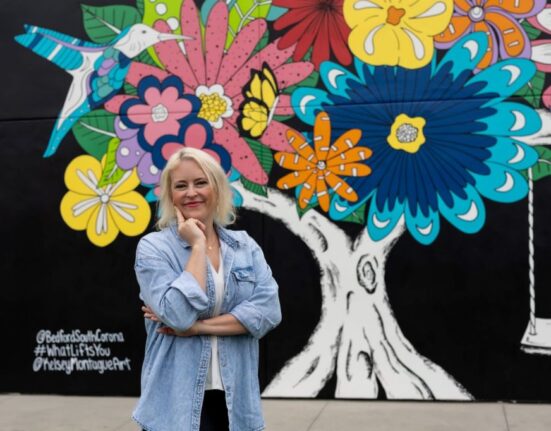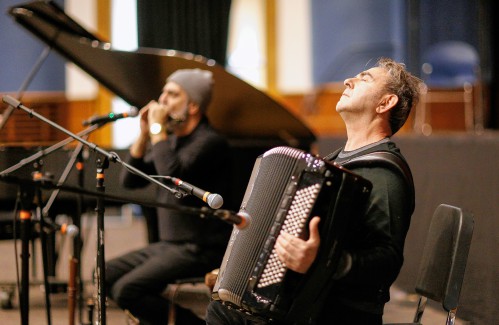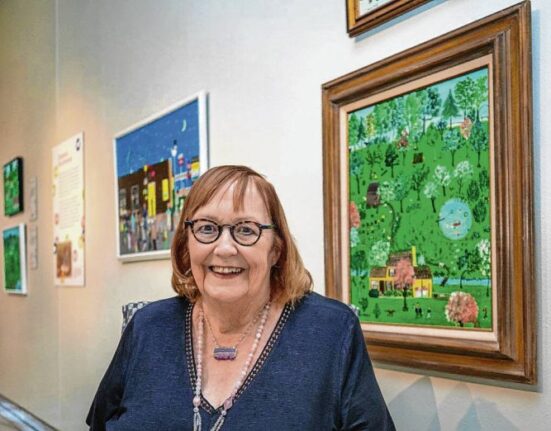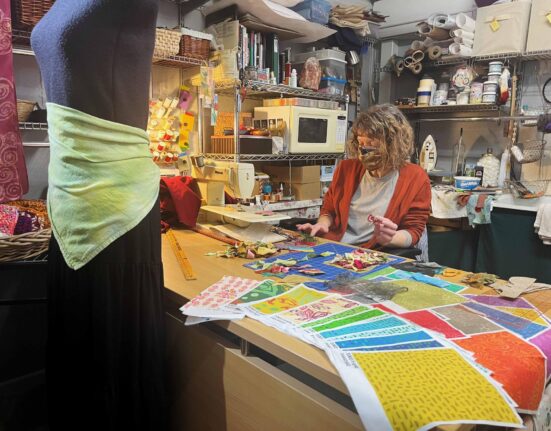In a sun-drenched studio in a small village not far from Beit Shemesh, five artists about to have a group show in Tel Aviv are drawing. They concentrate fully on their new work and aren’t distracted by thoughts of their upcoming gallery exhibition.
That’s because these artists, residents of a community called Kfar Shimon, are on the autism spectrum and don’t worry about what critics will say or whether people will show up at the exhibition, the way most creators do.
The exhibition, titled “Village Works,” will be held at ArtSpace Tel Aviv (6 Shvil Hameretz Street). A festive opening event will take place on July 11, and the exhibition will run until July 27. ArtSpace is a contemporary art gallery and nonprofit supported by the Tel Aviv-Jaffa Municipality and the Culture and Sport Ministry. The exhibition will feature a gallery talk on July 19 by Ruthie Director, a curator, critic, and lecturer, along with Ilan Blum, the former director of Kfar Shimon; and Nvo Svory, director of the Kfar Shimon art workshop.
Music plays in the studio as the artists draw. Most are quiet, but one asks Svory when another staff member will be returning from his vacation, while a second artist talks about whether the noise of a vacuum cleaner can hurt people and eventually convinces himself that it can’t. There are no vacuum cleaners running anywhere nearby, and the first artist asks the question about the vacationing staffer perhaps 10 times in 20 minutes, but that’s just part of the routine here.
All the while, their hands are busy – outlining, coloring, creating. One young woman works on a canvas that is a collaborative effort by several of them. On the tables are piles of National Geographic magazines, which Svory encourages them to thumb through when they are looking for inspiration for their imagery.
IT’S PROBABLY the right moment for me to disclose that I am the mother of one of these artists. For five years, my adult son who is on the autism spectrum has been a resident of Kfar Shimon, a residential and occupational program for autistic adults in Israel, which includes workshops in music, dance, and various crafts, in addition to art.
As a parent, I don’t claim to be objective, but every time I pick my son up for the weekend, I find myself transfixed by the beauty of the artworks that decorate the village, among them murals, sculptures, wooden toys, mosaics, wall hangings and baskets, in addition to paintings and drawings. The colors and patterns are intense as is the sheer depth of the imagination exhibited in these works. I am happy that others will now be able to enjoy this lovely artwork as much as the artists, their families, and the village staff do.
A guide for autistic artists
Svory, an artist who has been working at Kfar Shimon for more than a decade, sees himself more as a guide than a conventional teacher. Showing me a colorful drawing by Noga, one of the artists whose work will be featured in the show, he said that she often draws pictures of the photographs in National Geographic.
“She likes to draw women from around the world in colorful clothes,” he noted, pointing to a photo that inspired one of her drawings that depicted a number of women in native North African dress. “Her drawing is exactly the picture, exactly the people, but it’s totally hers. It’s a kind of genius.”
Like the rest of the staff at Kfar Shimon, he is willing to invest years in helping his students learn artistic technique, which is unusual in programs for adults on the spectrum, whose workday often consists of nothing more than moving pieces of plastic from one box to another.
“I give them technical help, I help them try to understand what they want to create,” he said. He reminds one of his students to make short strokes rather than big, uncontrolled ones, part of a process by which the student is acquiring new tools for self-expression.
“It’s a big achievement,” he said, noting that the young man is now able to use the markers in a much more controlled way than he had when he first walked into the workshop several years ago. “He has been working on this for more than two years, and now it’s easy for him. He enjoys being able to create different kinds of lines.”
The variety among the students’ work is extraordinary. One creates beautiful paintings and drawings made up of tiny, color-filled boxes depicting faces, animals, landscapes, and masks, as well as abstract designs. Another makes canvases that look like comics, with dozens of figures taking part in various activities, such as a picnic so joyful that people eating watermelon slices levitate above the grass. Many of the artists fill their pages with brilliant colors.
Some tend to stick to certain themes, such as rows of houses – or, in the case of my son, ceiling fans, which he feels are the most beautiful objects in all of creation. But while once he drew the exact same fan over and over, now he creates images of all sizes and colors, with fans hovering over buildings on city streets or floating next to people.
Without Svory’s instruction and encouragement, I don’t think he would ever have made this leap. Equally important is that he enjoys drawing now, as he never did before.
On show
Oded Korati, the director of Kfar Shimon, discussed the decision to have their work shown in a gallery.
“The exhibition is a tribute to Nvo’s ability to allow every resident to develop artistically in a way that is unique and different, which is something that is rare in other settings with people on the autism spectrum, where their ability to express themselves is generally limited. It’s very important that the residents have this opportunity to express themselves in this way,” he said.
“But we are also curious to see if their work is regarded as art by people outside the village… In our contact with Yair Barak,” the curator of the exhibition for ArtSpace, “we understood that it is of interest. This made me very happy, and I’m still very interested to see how people will respond.”
When Barak, an artist who teaches at the Kibbutzim College of Education, first saw the pictures by the Kfar Shimon artists, he said, “I was overwhelmed… I knew it was emotional and interesting enough to do an exhibition of it. I saw a body of work of exceptional artistic style and language.”
He said the exhibition is not simply a novelty for people who enjoy so-called “Outsider Art” or are curious about autism: “I was interested in the works, regardless of all other considerations.” He deliberated whether or not to mention in the publicity for the show that the artists are on the spectrum but decided to go ahead.
He pointed out that unlike most other Outsider Art, which is often done by the mentally ill or prisoners, the majority of the Kfar Shimon artists cannot articulate in words the vision behind their art, and so for many, it is one of their primary means of self-expression and communication.
PERHAPS THAT is why, Barak feels, that each of the Kfar Shimon artists has such a clear individual style. “Most artists work years until they have a thumb print – their own artistic style – but these artists each have their own language. Like Basquiat or Picasso or Warhol, they have their repetitions, their fixations, and their themes and variations, which creates a distinct look for each of them. I have only been to Kfar Shimon twice, but I can look at the works and know instantly who the artist is.”
He praised Svory’s work with them, saying, “He doesn’t tell them what to do,” noting there is a reciprocity in his approach. “He creates with them, he doesn’t tell them what to create… It’s clear from the variety of the work, that they come up with their own style, an identifiable language. For some, it’s a kind of magical realism that is very vivid… Some take their inspiration from ancient art, some seem to have come up with a version of pointillism, and some use images that resemble pixels.”
Calling the exhibition “Village Works” was not coincidental, he said, because “In the history of art, there were artists from the city who went to villages to paint, like in Aix en-Provence and Giverny. Artists like Van Gogh, Monet, and Picasso had periods living and working in villages. Suddenly, after visiting, it seemed to me that Kfar Shimon is a village like Aix en-Provence in a way: It’s a rustic, beautiful place where people create.”
Korati echoed this thought, saying, “We’re a small place, in a quiet area, and that’s good. But there is something worthwhile about taking the residents’ work out into the world to see how people will react and to allow them to see it in a different place.”
The artists and the rest of the Kfar Shimon residents will visit the gallery to see the show at least once. Korati said he thought it would make a positive impression on the artists to see their drawings hanging in a gallery in a neighborhood full of galleries, even though they may not be able to express in words exactly what the experience means to them.
“All drawing is a process,” Svory said. “All creation is a process, and showing the work to people at the end is a part of the process, for the people here just as it is for any artist.”
Said Barak: “When I look at their art, I see a body of work that impresses me. Knowing the context makes me even more fascinated: that they are expressing here what they can’t say with words. That’s a cliché, maybe, but there is so much communication in these works.” ■
For more information: www.artspacetlv.org/






